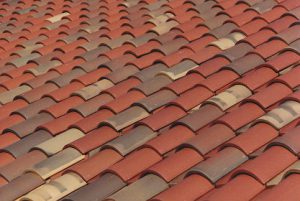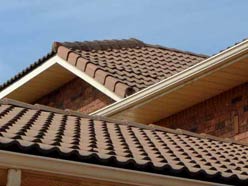Clay
Property



Clay roof tiles
Today, the manufacture of clay tiles starts with shale that is crushed to a fine powdery clay. The clay is mixed with water and kneaded, or pugged, to the consistency of cookie dough. Then to produce siple clay tiles, this moist, plastic clay is extruded through a die, and sliced into lengths. From there, they go to a kiln for firing. [1]
Colouring






The more sphisticated clay tile manufacturers achieve colours through the careful blending and mixing of various clays into complex clay bodies. To broaden the color range of natural clay, roof tile manufacturers can mix the clay with natural metallic oxides prior to the firing process or apply colored glazes. Another method is to spray a thin creamy layer of clay, called a slip, onto the tile before its is fired. The most expensive way to colour tile is by glazing. For glazed clay tile, extremely high kiln temperatures react with the glaze, which then becomes an integral part of the tile surface and creates the rich, often vibrant, final tones of the tile. The metallic pigments in the glaze, when fired, melt to a glossy, vitreous, richly coloured surface, much like that found on ceramic tile used indoors. [1]
Composition
- 50.90% SiO2
- 34.73% Al2O3
- 0.33% K2O
- 0.33% Na2O
- 0.28% MgO
- 0.28% CaO
- 1.34% Fe2O3
- 1.81% TiO2
- 9.99% L.O.I
Specific Gravity
2.6
Melting Point
3000 °F
Fire
Very good fire resistant
Enamel
A vitreous substance made of finely powdered glass colored with metallic oxide and suspended in an oily medium for ease of application with a brush. The medium burns away during firing in a low-temperature muffle kiln (about 965-1300° F or 500-700°C). Sometimes, several rings are required to fuse the different colors of an elaborately enameled object.